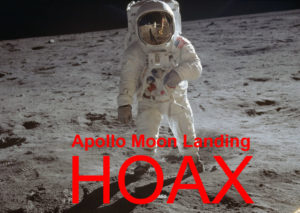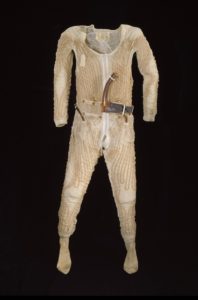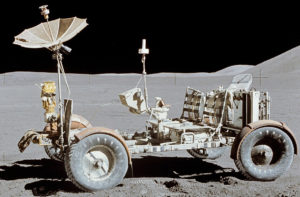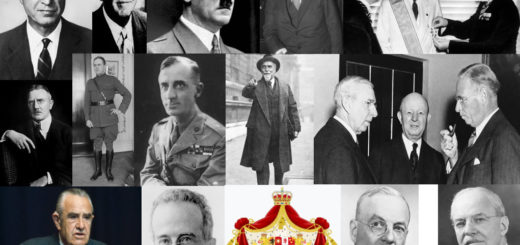Why the moon landing was a hoax: The greatest government conspiracy of all time.

The Space Age
The race to the moon between the Soviet Union and the United States was a defining moment in the history of space exploration and the Cold War. It was a competition between two superpowers, both vying for technological and ideological supremacy. The competition was unparallel. Both countries spent billions to outdo the other. The Soviet Union launched the first orbiting satellite, the first animal in space, the first man. They had logged 500% more hours in space than the United States. The Soviet Union, right up until the time that we allegedly landed the first Apollo spacecraft on the Moon, was solidly kicking our ass in the space race. It wasn’t even close.
Everything the U.S. did, prior to actually sending a manned spacecraft to the Moon, had already been done by the Soviets, who clearly were staying at least a step or two ahead of our top-notch team of imported Nazi scientists.
In June of 1969 they launched an unmanned probe to the moon to retrieve the first soil sample from another world, just one month before Apollo 11. That’s how close the race was. Had their unmanned probe not crashed landed into the lunar surface, the first moon rock brought back to earth would have been by the Soviet Union.
The race to the Moon was important for several reasons:
- Technological Achievement: It showcased the technical capabilities of both nations, stimulating advances in science and engineering.
- National Prestige: The space race was closely tied to national pride and prestige. Each success or failure was seen as a reflection of a nation’s political and economic system.
- Military Significance: The ability to launch objects into space also had military implications, such as the potential for intercontinental ballistic missiles.
- Scientific Discovery: The missions provided valuable scientific data about the Moon and space, helping to advance our understanding of the universe.
- Inspiration: The space race inspired generations of scientists, engineers, and young people to pursue careers in STEM fields.
The race to the Moon ultimately concluded with the United States achieving its goal, as the USSR abandoned its lunar program. The Apollo 11 mission and the subsequent Apollo missions helped cement American leadership in space exploration. It also marked a turning point in the Cold War, with both nations later collaborating on space endeavors, such as the Apollo-Soyuz Test Project in 1975, which helped ease Cold War tensions. The legacy of the space race continues to influence space exploration and international cooperation in the field to this day.
Van Allen Belts
The number one reason the Apollo missions are a lie is the Van Allen Radiation Belts. Beginning with an altitude of 1,000 miles and extending an additional 25,000 miles are the Van Allen Belts. Van Allen Belts are composed of lethal radiation. Every manned space mission in history has been below this deadly radiation field except for the Apollo missions. For the two-hour journey through the Van Allen Radiation Belts required to reach the moon, it would take solid lead shielding between the astronauts and additional exposure outside would be needed. The mammoth Saturn 5 rocket used by Apollo was already 35 stories tall and weighed as much as a battleship. To add additional lead tonnage to protect the astronauts would have made it impossible for the rocket to get off the ground. In many places, the shielding on Apollo was less than an 1/8 of an inch of light aluminum.
(*NASA gives the distance from the center of Earth to the center of the Moon as 239,000 miles. Since the Earth has a radius of about 4,000 miles and the Moon’s radius is roughly 1,000 miles, that leaves a surface-to-surface distance of 234,000 miles. The total distance traveled during the alleged missions, including Earth and Moon orbits, ranged from 622,268 miles for Apollo 13 to 1,484,934 miles for Apollo 17. All on a single tank of gas.)
In 1998 the Space Shuttle flew to an altitude of 350 miles, one of its highest altitudes ever. Hundreds of miles below a field of radiation. The radiation on the astronauts on board was so severe that they saw flashes of light with their eyes shut that they described as shooting stars.
When interviewed, Alan Bean of Apollo 12 initially stated he had not gone through the belts and did not observe any effects caused by them. “No, I’m not sure we went far enough out to encounter the Van Allen radiation belts…maybe we did?” When it was pointed out that the flight pattern took him through the belts, he changed his story.
20 years after the Apollo missions and years behind schedule the same space program couldn’t put into earth’s orbit a telescope with a lens that focused, and yet two decades earlier a mission 100 times more complicated worked on its first occasion.
“I believe that this nation should commit itself to achieving the goal, before this decade is out, of landing a man on the Moon and returning him safely to the Earth. No single space project in this period will be more impressive to mankind, or more important for the long-range exploration of space; and none will be so difficult or expensive to accomplish.”
This speech marked the beginning of the Apollo program, which ultimately led to the successful moon landing by NASA’s Apollo 11 mission on July 20, 1969, with astronauts Neil Armstrong and Buzz Aldrin becoming the first humans to set foot on the lunar surface. President Kennedy’s vision and commitment to space exploration played a significant role in advancing the United States’ space program during the 1960s. – John F. Kennedy
The Apollo’s spacecraft narrowest shielding was less than one eight of an inch thick of light aluminum. In 1998, the Space Shuttle flew to an altitude of 350 miles. One of it’s highest altitudes ever. Hundreds of miles below a field of radiation that was so severe that the astronauts onboard inside of their shielded spacecraft and inside of their shielded spacesuits saw flashes of light with their eyes shut as they described as shooting stars due to radiation first penetrating the shuttles shielding, then their spacesuit shielding, then their skulls and finally their retinas of their closed eyes.
As a result, CNN issued the following report noting NASA’s unpredicted surprise – The radiation belts surrounding earth maybe more dangerous for space walking astronauts than previously thought. Sceinctist say that the
Moon Photos
There are only 12 full bodied pictures of Neil Armstrong on the moon. Many of the photos from the Apollo missions have unnatural shadows, causing speculation they were shot with additional lighting. From an analytical standpoint, if all the photos shot on the moon were lit solely by the sun as all the scenes on the moon were said to be, after all lighting equipment was unnecessary, then all shadows regardless of the landscape would run parallel with one another and never intersect. In many of the rare scene photographs, it is clear these scenes were lit with artificial light. These shadows are cast at different angles is evident that a second light source was used. The sun wouldn’t also cause isolated hot spots in the photos. It is impossible for many of the photos just to be taken with sunlight on the moon. Some of the photos have crosshairs that are behind the objects being photographed.
Several photos have the sun in the back of the astronaut and the front of the spacesuit is well lit. This means there were other light sources used.
Several photos have the horizon at an unnatural position. The famous photo of Buzz Aldrin on the moon with the horizon behind his head is wrong if the photo was really being taken by Niel Armstrong with the camera mounted on his chest. If it were really the case, the horizon would have been much lower.
Someone also forgot to create a burn crater underneath the Lunar Modul’s 10,000 pound trust engine. This is despite the fact that on the ground there was a concern the Lunar Modul would fall into the hole the engine would have created. It looks as if the Lunar Modul was simply placed there. There is not a single speck of moon dust on the landing pod.
What about stars? On the moon with no atmosphere, they must have been a site to behold. There is seldom any mention of the stars from any of the astronauts on any of the missions. Undoubtably, creating a mural of properly placed constellations properly placed in the sky would have been impossible to create accurately, much less realistically. A competent amateur astronomer would have been able to call attention to even the slightest error in measurement. The answer, not to talk about the stars, ever. In their post flight press conference, it was the only question that Neil Armstrong responded with an absence of memory.
“I don’t recall while were photographing the solar corona what stars we could see.” Neil Armstong “I don’t remember seeing any.” Michael Collins. But, years later Michael Collins would remember seeing the illusive stars and wrote about them in his book Apollo Expedition to the Moon. It seems his memory improved the older he got.
While they took three Rover’s to the moon, they never took a photographic telescope. Had they done so, they would have been able to see further into the universe that had ever before been realized. By the way, the cost of the Moon Rovers in 21st century currency was 60 million dollars, each. And, they had fewer parts than a Jeep. Where was all this money going?
If you look at many of the Moon Rover photos, you’ll notice there are missing tracks in the sand as to how the Rover got where it did. It’s like it was put in the sand by a crane.
Then there’s the flag, blowing in the wind at least twice on the atmosphere-less moon.
The camera equipment at that time didn’t have auto focus. Each photo would have to be focused, set the shutter speed and the aperture set. How did they do that wearing a space suit looking straight down at the viewfinder and wearing those space gloves?
“Once on the Moon, on the lunar surface in the dress, in the life support system, you couldn’t see the camera. They couldn’t bend their head that far down to see the scale … They had no viewfinder – they had to aim by moving their body.” – Jan Lundberg, chief designer of the Hasselblad cameras allegedly used by the Apollo astronauts.
“They had to effectively guess where they were pointing the camera.” – HJP Arnold, the Kodak executive who supplied the Ektachrome film for the missions.
Since we’re on the subject, I have to mention that transmitting live footage back from the Moon was another rather innovative use of 1960s technology. More than two decades later, we would have trouble broadcasting live footage from the deserts of the Middle East, but in 1969, we could beam that shit back from the Moon with nary a technical glitch!
Caught Faking the Earth Photo
In rarely seen footage, there is a conversion between the astronauts and Houston control, there is a secondary private conversation taking place between the crew and a third confidential party. This person prompts the astronauts what to say, when to speak and how to manipulate the camera to achieve the desired misleading effect. NASA claims that the Houston’s transmissions were the only ones taking place with the astronauts. Houston tries to communicate to the crew only to find them too preoccupied with the behind-the-scenes trickery to respond. Moments pass and you can hear the unidentified third party who quickly prompts them with “talk.” Immediately Neil Armstrong speaks. The illusion the crew is attempting to create is a picture of earth at a distance to demonstrate their far journey from it and their ability to survive passing through the Van Allen Radiation Belts. Only about 20 seconds of this raw footage was ever broadcast to the public. These conversations discussing their deception was believed to be private. They discuss the fact they have turned out the lights and blocked out sunlight from entering the spacecraft through the other windows. This was to ensure that no other light would fall on the spacecraft walls.
Aldrin, “We shut out the sun coming in some of the other windows into the spacecraft (so that the inside walls do not show). We’re looking through the number one window so there is no other reflected light.” The reason this was done is so the truth of the matter would not be revealed. The federal government would have you believe the picture of the moon through the window is from close to the moon, but it is not. What the crew had done was place the camera at the back of the spacecraft and centered the lens on a circular window in the foreground. Outside the window is completely filled with the earth in low orbit. The circumference of the window makes it appear to be the earth at a distance. The blackness in the spacecraft appears to be the blackness of space around the earth. That is why they wanted the interior dark and blocked out the sun from entering the other windows. During this segment, intended to be edited and played back later for the world wide television audience, dated July 18th 1969 Neil Armstrong condemns himself by stating they are 130,000 miles out, or halfway to the moon. In reality, he is in low earth orbit, a few hundred miles out.
“We only have one camera with a view of the earth and it’s filled up with a TV camera,” Neil Armstrong. If the window was completely filled up with a TV camera, as he stated, then an astronaut’s arm wouldn’t be able to get between the camera and the window. As it did in an outtake.
Later that evening, they were said to be walking on the moon, but how could that be if they were in earth’s orbit only 9 hours earlier. The moon was supposed to be 3 day’s journeys away. Furthermore, if they genuinely went to the moon, why would they be faking any part of it? Why this trickery with the window? By faking being halfway to the moon, it becomes apparent that they can’t even go halfway to the moon. This confirms that the stumbling block to going to the moon is the Van Allen Radiation Belts.

Moon Temperature & Space SuitsThe temperature on the Moon varies significantly depending on its location and time of day. The Moon experiences extreme temperature variations due to its lack of atmosphere. During the day, temperatures on the Moon’s surface can soar to around 260 degrees Fahrenheit or even higher in direct sunlight. This intense heat is because there is no atmosphere to trap heat or regulate temperatures.
Conversely, during the lunar night (or in the shadows), temperatures plummet drastically. In the absence of an atmosphere to retain heat, the Moon’s surface can drop to incredibly frigid temperatures, reaching as low as -280 degrees Fahrenheit.
The lack of atmosphere on the Moon means there is no insulation or protective layer to moderate these temperature extremes, making it an incredibly harsh environment for human exploration. To survive in these conditions, the Apollo lunar missions needed to incorporate advanced thermal control systems to cope with the extreme temperature swings.
The spacesuits used in the Apollo program were known as the Apollo/Skylab A7L suits. These spacesuits were specially designed to protect astronauts from the harsh environment of space, including the vacuum, extreme temperatures, micrometeoroids, and solar radiation. The A7L spacesuit consisted of multiple layers to provide thermal control, life support, and pressure containment. They also had a gold-coated visor to protect against the intense solar radiation and glare on the lunar surface.
These spacesuits had no ability to cool the astronauts in the sun then immediately heat them when in the shade. The Apollo spacesuits, including the A7L suits, underwent extensive testing, but the vast majority of these tests were conducted by NASA and its contractors in controlled environments, such as vacuum chambers, thermal chambers, and other specialized facilities. These tests were not public events. The only public exposure to the spacesuits was during the pre-launch coverage and the spacewalks on the moon.
The lunar spacesuits were actually created by a lingerie company, Playtex. Playtex was known for the “cross your heart bra.” This is the company that was given the contract to protect the astronauts from the airless environment and temperatures extremes. As Nicholas de Monchaux recounts in his 2011 book “Spacesuit,” NASA managers forced Playtex to work under the supervision of an aerospace company, Hamilton Standard, which submitted a suit that was rejected. Playtex employees then snuck into Hamilton Standard, snatched back their design, resubmitted it and won the contract.
Playtex’s industrial division, ILC Dover, has designed every NASA spacesuit since then.
Some conspiracy theorists believe there is a mismatch between a space boot and the lunar footprint proves the moon landing was fake. The conspiracy theory overlooks the fact that astronauts wore lunar overshoes over their boots. Those overshoes were treaded, while the astronauts’ boots were not. After completing the moonwalk, Armstrong and Aldrin left the lunar overshoes behind to save weight on the spacecraft. Very convenient.
Let’s for a minute believe that is true. If that’s the case, then their regular boots had to keep their feet protected from 260 degrees Fahrenheit. Their regular boots didn’t appear to have an appropriate way to keep their feet cool. It’s important to note that cooling from 260 degrees Fahrenheit to a comfortable and safe temperature would require significant energy and specialized equipment. The choice of cooling technology would depend on the specific application and the requirements of the system in question. NASA says that liquid cooling garments were worn by the Apollo astronauts underneath the spacesuit and were designed to keep the astronaut’s body temperature within normal ranges by allowing cool water to circulate through the tubes. However, there are zero tubes in the boots.
I realize the air on the moon is not hot because the moon does not have a substantial atmosphere like earth. In fact, the moon is often described as having a “vacuum” or “near-vacuum” environment because it has an extremely thin exosphere that lacks the gases that make up a typical atmosphere. However, that doesn’t mean the temperature of the spacesuit and space boots were not extremely hot. Way beyond 1969 technology.
We are also going to need to install a top-of-the-line heating and cooling system for the Lunur Modul. Probably several of them, actually. Because the ‘weather’ on the Moon, so to speak, can be a bit unpleasant. Again, according to the experts over at NASA, daytime highs average a balmy +260° F, but it cools off quite a bit at night, dropping to an average of -280° F. If you’re looking for anything between those two extremes, you won’t really find it on the Moon. It’s pretty much one or the other. If you’re in the sun, you’re going to be boiled alive, and if you’re out of the sun, you’re going to be flash frozen.
I’m not at all sure how the air conditioning system is going to work, come to think of it, since air conditioning requires a steady supply of – and please stop me if I am stating the obvious here – air. And the Moon doesn’t really have a lot of that.

Moon Buggy
In addition to all the other material and equipment, our spaceship is now so ridiculously overloaded that we may have had to add a roof-rack. We have a couple more items to pack, and we probably should have gotten them on sooner because they are going to require a lot of space. On some of the later Apollo flights, we also have to pack a dune buggy, otherwise known as a lunar rover. And the rovers, according to NASA, are a full ten feet long, just two feet less than the diameter of the craft. But not to worry – according to NASA, the rovers folded up to the size of a large suitcase. When released, they would just sort of magically unfold and snap into place, ready to roam the lunar terrain.
To be perfectly honest, I’m not really sure why we have to take the rover. There is no real compelling reason to take it to the Moon … except for the fact that they make for good TV, and that seems to be of paramount importance. Not really sure how it really fit in the spaceship.
One last thing we’re going to need is a whole lot of batteries. Lots and lots of batteries. That’s going to be the only way to power the ship while we’re on the Moon, and we’ll definitely need to run the communications systems, and the oxygen supply system, and the heating and cooling system, and the cabin lights, and the television cameras and transmitters, and all the testing equipment, and our spacesuits, and that damn rover. And we won’t be able to recharge any of the various batteries, so we’re going to need a lot of back-ups. Especially of the really big batteries that run the ship. We may need a separate ship just to carry all the batteries we’re going to need.
Telemetry Data
Telemetry data refers to a collection of measurements and information that is transmitted from remote or distant sources to a central location for monitoring, analysis, and control. It is commonly used in various fields, including aerospace, telecommunications, medicine, and environmental monitoring.
Here are some key aspects of telemetry data:
Data Collection: Telemetry systems collect various types of data, such as temperature, pressure, speed, position, electrical voltage, or any other measurable quantity. This data can come from sensors, instruments, or remote devices.
Transmission: Telemetry data is transmitted from the source or the remote location to a central receiving or monitoring station. This transmission can occur through various means, including radio signals, wired connections, or wireless networks. In space exploration, for example, telemetry data is often transmitted via radio waves.
Real-Time Monitoring: Telemetry data is typically sent in real-time, allowing operators or analysts to monitor the status of the remote system or equipment as it operates.
Analysis and Control: The received telemetry data is analyzed to assess the condition and performance of the remote system or equipment. It can be used to make operational decisions, detect issues or anomalies, and remotely control the system or device.
Safety and Maintenance: Telemetry data is vital for safety and maintenance in various industries. For example, aircraft and spacecraft rely on telemetry data to ensure their systems are functioning correctly and to identify and address any potential problems.
Environmental Monitoring: Telemetry is used for environmental monitoring in fields such as weather forecasting, earthquake detection, and ecological research. Data collected from remote sensors in these cases provides valuable information for research and disaster prediction.
Remote Data Logging: Telemetry data is often stored for record-keeping, analysis, and historical reference. This can help identify trends and patterns over time.
Telemetry systems play a crucial role in enabling remote monitoring, control, and data collection across a wide range of applications. They are instrumental in ensuring the safe and efficient operation of complex systems, from spacecraft to industrial machinery to environmental monitoring networks.
NASA spokesperson has said all the Apollo telemetry data is missing. Could this be true? Mankind’s first interplanetary exploration and original science data is missing. Very convenient.
As it turns out, however, NASA doesn’t actually have all of that Moonwalking footage anymore. Truth be told, they don’t have any of it. According to the agency, all the tapes were lost back in the late 1970s. All 700 cartons of them. As Reuters reported on August 15, 2006, “The U.S. government has misplaced the original recording of the first moon landing, including astronaut Neil Armstrong’s famous ‘one small step for man, one giant leap for mankind’ … Armstrong’s famous moonwalk, seen by millions of viewers on July 20, 1969, is among transmissions that NASA has failed to turn up in a year of searching, spokesman Grey Hautaluoma said. ‘We haven’t seen them for quite a while. We’ve been looking for over a year, and they haven’t turned up,’ Hautaluoma said … In all, some 700 boxes of transmissions from the Apollo lunar missions are missing.”
Taxpayer Investment
The Apollo program spent billions of dollars. If it failed to achieve its goal with such an investment, it would be a large bitter pill for the taxpayers to swallow. The cost of the program, with a sole goal to land a man on the moon was $135 Billion Dollars (adjusted for the 21st century). With a profit goal of 9%, it would generate $9 Billion Dollars going to the privileged contractors chosen by their friends at NASA. Huge American corporations, many of which were manufacturing hardware for the military made gigantic profits designing space vehicles and lift-size models of spaceships.
$135 Billion Dollars could feed 2 million people for their entire lives. It could also buy 2 million 2-bedroom houses.
Neil Armstrong
Throughout the years and up to his death, Neil Armstrong gave very few interviews. On the 25th anniversary of the event in 1994 Neil Armstrong made a rare public appearance and held back tears as he spoke these brief cryptic remarks before the next generation of taxpayers.
“Today we have with us a group of students among America’s best. To you we say we’ve only completed a beginning. We leave you much that is undone. There are great ideas undiscovered. Breakthroughs available to those who can remove one of truth’s protective layers.
Neil Armstrong passed away on August 25, 2012, and was laid to rest in the Atlantic Ocean. This unique and symbolic burial at sea took place on September 14, 2012. It was a private ceremony conducted for the family, and it honored Armstrong’s wishes for the simple and private disposal of his remains.
The decision to have his remains scattered at sea was made to avoid the creation of a public gravesite or monument and to maintain a sense of privacy and dignity, which Armstrong and his family greatly valued. Armstrong probably understood that at some point in history the world would discover the truth about the fake mission. More than likely, he didn’t want people to desecrate his burial ground and make jokes about the biggest lie in human history.
James E. Webb
James E. Webb served as the Administrator of NASA from February 14, 1961, to October 7, 1968. He was appointed by President John F. Kennedy and continued to serve through President Lyndon B. Johnson’s administration. During his tenure, Webb was instrumental in directing NASA’s efforts to achieve President Kennedy’s goal of landing a man on the Moon and bringing him safely back to Earth before the end of the 1960s.
Under Webb’s leadership, NASA made significant progress in the Apollo program. Webb’s departure from NASA came after the Apollo 7 mission in October 1968, which was the first crewed mission in the Apollo program. He left NASA on October 7, 1968, having served as Administrator for over seven years. Why would he leave the program right before the Apollo 11 mission? Just 9 months before the so-called moon landing?
Was his decision to resign influenced by a fake plan to send astronauts to the moon? Why, when he was on the threshold of achieving the greatest accomplishment of his career? The greatest accomplishment in the history of the world? All three Apollo 11 astronauts resigned shortly after their return.
Don Pettit – Nasa Astronaut
“I’d go to the moon in a nanosecond. The problem is we don’t have that technology to do that anymore. We used to but we destroyed that technology and it’s a painful process to build it back again.”
Technology
There has been revolutionary change in entertainment and communications technology, so too has aerospace technology advanced by light-years in the last five decades. Technologically speaking, the NASA scientists working on the Apollo project were working in the Dark Ages. So if they could pull it off back then, then just about anyone should be able to do it now.
It would be particularly easy, needless to say, for America to do it again, since we’ve already done all the research and development and testing. Why then, I wonder, have we not returned to the Moon since the last Apollo flight? Following the alleged landings, there was considerable talk of establishing a space station on the Moon, and of possibly even colonizing Earth’s satellite. Yet all such talk was quickly dropped and soon forgotten and for nearly five decades now not a single human has been to the Moon.
Political
The real question is why such a ruse would be perpetrated, we must transport ourselves back to the year 1969. Richard Nixon has just been inaugurated as our brand new president, and his ascension to the throne is in part due to his promises to the American people that he will disengage from the increasingly unpopular war in Vietnam. But Tricky Dick has a bit of a problem on his hands in that he has absolutely no intention of ending the war. In fact, he would really, really like to escalate the conflict as much as possible. But to do so, he needs to set up a diversion – some means of stoking the patriotic fervor of the American people so that they will blindly rally behind him.
In short, he needs to wag the dog.
This has, of course, traditionally been done by embarking on some short-term, low-risk military endeavor. The problem for Big Dick, however, is that a military mission is exactly what he is trying to divert attention away from. What, then, is a beleaguered president to do? Why, send Neil and Buzz to the Moon, of course! Instead of wagging the dog, it’s time to try something new.
Nixon’s actions from the very moment he takes office belie his campaign pledges to the American people (not unlike that Barry Obama guy, who also led the American people to believe that he opposed an unpopular war). In May of 1969, with Nixon just a few months into his term, the press begins publicizing the illegal B-52 carpetbombing of Cambodia engineered by that irrepressible war criminal, Henry Kissinger. By June, Nixon is scrambling to announce what is dubbed the ‘Vietnamization’ of the war, which comes with a concomitant withdrawal of U.S. troops.
In truth, however, only 25,000 of the 540,000 U.S. troops then deployed will be brought home. This ruse is, therefore, transparently thin and it will buy the new president little time. To make matters worse, on July 14th, Francis Reitemeyer is granted Conscientious Objector status on the basis of a petition his attorney has filed which explicitly details the training and instruction he has just received in assassination and torture techniques in conjunction with his assignment to the CIA’s Phoenix Program. With these documents entering the public domain, the full horrors of the war are beginning to emerge.
Just in time to save the day, however, Apollo 11 blasts off on July 16th on its allegedly historic mission, and – with the entire nation enthralled – four days later the Eagle purportedly makes its landing on the pristine lunar surface. Vietnam is temporarily forgotten as America swells with patriotic pride for having beaten the Evil Empire to the Moon. There is little time to worry about the brutality of war when Neil is taking that “one giant leap for mankind.”
The honeymoon is short-lived, however, for just four months later, in November of 1969, Seymour Hersch publishes a story about the massacre of 504 civilians in the village of My Lai, bringing home to America the full savagery of the war in Southeast Asia. It’s time then for another Moon launch, and Apollo 12 dutifully lifts off on November 14th, making another picture-perfect lunar landing before returning on November 24th. The country is once again entranced by the exploits of America’s new breed of hero, and suddenly every kid in the country wants to grow up to be an astronaut.
The crowning achievement of humankind, the greatest boost of the species, the event in history most associated with pride in our own accomplishments…landing on the moon. It all was a hoax.
Space may be the final frontier but it’s made in a Hollywood basement
And Cobain can you hear the spheres singing songs off Station To Station?
And Alderaan’s not far away, it’s Californication












Recent Comments